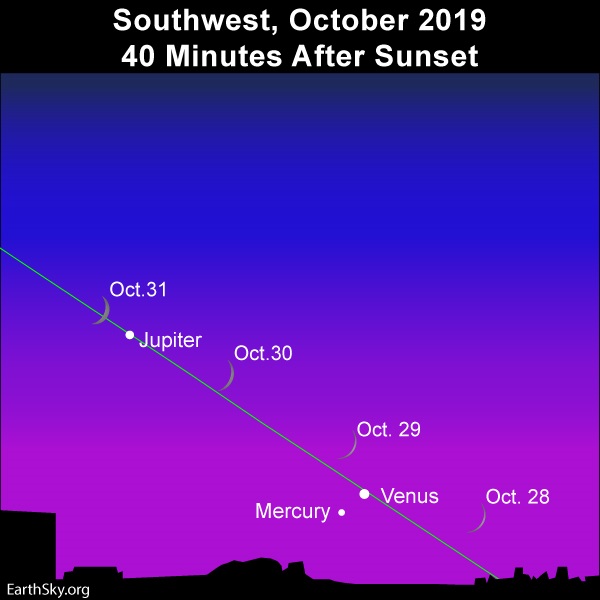
Venus in the Evening Sky from 2019 to 2020 from Larry Koehn on Vimeo.
Have you been missing the brightest planet Venus? I know I have. It’s been gone from our sky for several months, passing behind the sun from Earth’s point of view. Venus’ superior conjunction was August 14; that was when it was most directly behind the sun from us, traveling on the far side of the solar system, lost in the sun’s glare to all earthly observers. Photographers using telephoto lenses began to spot Venus again in early to mid-September. It’s been visible from Earth’s Southern Hemisphere since late September, because, from there, the ecliptic, or sun’s path, is angled more perpendicularly to the evening horizon at this time of year. We in this hemisphere will begin to see Venus again, low in the west very shortly after sunset, this month. Can’t wait? This video tracks a telescopic view of Venus, from when it reappears in the evening sky in September-October 2019, all the way to May 2020. EarthSky friend Larry Koehn of the great website shadowandsubstance.com made this animation. He wrote at Vimeo:
Venus will stay with us after sunset from September-October 2019, through May 2020. Venus will reach inferior conjunction [passing between us and the sun] on June 3 of 2020, and, thus, return to the morning sky in June.
Mercury will appear three times above the horizon during this time period with the first appearance occurring this October.
Jupiter and Saturn can be seen approaching the southwestern horizon from October through January. You will note that Jupiter and Saturn will both travel in a straight line. Mercury and Venus will not!
Venus will exhibit various phases of illumination, as the months progress, much like the moon, with Venus reaching less than 10 percent illumination (crescent phase) in May 2020.
All animations are set for exactly 30 minutes after sunset.
Thank you, Larry!
By the way, why will Venus begin to show phases toward the end of its evening apparition in 2020? And why does it get so much bigger, as seen through a telescope? The phases are because Venus is an inner planet. As it draws near to passing between us and the sun on June 3, it’ll turn its lighted face (its day side) increasingly away from us; hence, we’ll see a waning Venus. Its size in our sky is about the distance between us and Venus. That distance will be decreasing, obviously, as Venus comes near to passing between us and the sun. Thus Venus will be at its largest as viewed through telescopes – and clearly brighter when viewed with the eye alone – shortly before it disappears into the sunset glare in late May.
Okay, so when will you see Venus again with the eye alone? We can’t say for sure. It depends on your sky conditions and on where you are on the globe. But all of us should be able to see Venus by late October, when the waxing crescent moon will sweep near it in the sky, as shown on the chart below:

The young moon will swing through in the vicinity of the planets Mercury, Venus and Jupiter in late October 2019. The above chart is for North American mid-northern latitudes. Click here for more information plus a Southern Hemisphere sky chart.
Bottom line: Video animation of the track of Venus (and other planets) from September-October 2019 to May 2020.
Read more: October guide to the bright planets
Source:
https://earthsky.org/astronomy-essentials/tracking-venus-in-late-2019-and-early-20